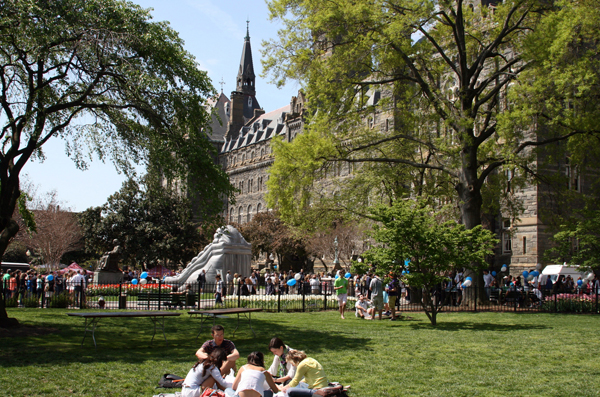当前位置: Language Tips> 英语学习专栏
大学四年,40门课程,120学分,换来一纸学历。这除了说明你有足够的自制力能够在座位上坐这么长时间之外,还能给你未来的雇主提供其他有价值的信息吗?先驱教育者提出改革,将知识与实用技能,学士与硕士学位有机结合,让学生真正学有所成,让学位不再是一纸空凭。这到底是一次颠覆性改革还是又一次徒劳尝试?我们拭目以待。

By Jeffrey J. Selingo
凡路 选注
Confronting the fact that the old ways of educating undergraduates are looking increasingly irrelevant, schools are adopting time-saving and flexible innovations.
Across from Washington, D.C.'s Georgetown University is a red clapboard house where this 226-year-old Jesuit university is trying to reinvent itself.
Georgetown has long enjoyed a top twenty-five spot in the U.S. News & World Report rankings and a stellar reputation among prospective students, who often choose between it and the top Ivy League universities. But Georgetown's endowment of around $1.4 billion pales in comparison to that of the University of Pennsylvania ($10 billion), Princeton ($9 billion), or Stanford ($22 billion). Without that kind of financial cushion, Georgetown's biggest boosters worry it may not continue to attract top students in the future, especially with an annual price tag of more than $60,000.

The "red house," as it is known around campus, opened in 2014 as an incubator to rethink the university's future. The cramped house is filled with posters dotted with sticky notes and elaborate drawings of models showing how students move through their undergraduate years. The chief architect of what happens in the house is Randy Bass, the vice provost of education and a popular figure on campus who still teaches undergraduates. Bass, who has a salt-and-pepper beard and a dry sense of humor, has focused much of his work in the last year on finding an avenue to increase the value of a Georgetown degree.
Bass told me higher education suffers from a measurement problem. "We only charge for a portion of what students see as the value of moving to a degree," he said. Tuition is tied to the credit hour, and 120 earns a bachelor's degree. But the credit hour doesn't actually measure how much students learn. It's simply an arbitrary measure of time spent in a seat, and it certainly doesn't tell employers much about the college graduates they're hiring except that they had the discipline to make it through four years of courses.
What's more, a degree based on time spent in a seat is inefficient because it forces all students to follow a single route to graduation (which, as we've seen, is not how the workplace operates). A new degree taking shape at Georgetown aims to strike out those inefficiencies and, at the same time, marry two competing interests: job skills and education. It would combine a liberal arts bachelor's degree with a vocational master's degree, all within the time frame of four years. Several universities already offer combined degrees, of course, but they typically take five years, and the master's experience is usually bolted on at the very end, almost as an afterthought.

Instead, Georgetown is rethinking the entire track to the degree. Professors have identified the competencies students need to learn for the merged undergraduate and graduate degrees. At most colleges, such competencies are tied to a course. Sit in a fifteen-week class and you've achieved the goal. By identifying the competencies associated with a degree, Georgetown can move away from the course as the sole measure of learning. Students could earn a competency in a fraction of a course or, more important, outside the walls of the university in internships or projects.
"That stuff that has been on the margins of the experience now are the bread and butter of this new degree," Bass said. "They are at the center of what we do."
The combined degree probably won't be less expensive than the four-year degree is now, but Bass believes it will be packed with more value. About one-third of Georgetown seniors already go part-time in their last semester because they have completed their degree requirements. In the future, perhaps they can get a master's degree during the downtime until graduation. Traditionalists keep asking Bass where in his model the bachelor's degree ends and the master's begins. But he envisions it as one integrated experience, where the undergraduate studies shrink over four years as the work associated with the master's grows. "Just maybe," Bass said, "we are creating a new kind of degree."
Such a degree is designed for the kind of student that Georgetown typically attracts - top of their class, academically focused, the type that usually sprints into a job after college. But college students are no longer the homogeneous group they were three or four decades ago. Yet they are still largely served by a one-size-fits-all delivery method - 40 courses equals a bachelor's degree. Now, when technology allows much of the content of those classes to be delivered outside specified time periods each week and even anywhere in the world, the idea of "the course" seems antiquated and increasingly irrelevant to growing segments of today's students.
Vocabulary
1. obsolete: 废弃的,淘汰的。
2. Georgetown University: 乔治城大学,创建于1789年,是一所综合性私立大学,美国最古老的大学之一;clapboard: (覆盖建筑物外墙的)护墙板;Jesuit: 耶稣会会士;reinvent: 彻底改造。
3. 一直以来,乔治城大学在《美国新闻与世界报道》的大学排名中都占据前25的地位,而且在学生当中一直享有星级版声誉,这些天之骄子们往往在乔治城大学和顶尖常春藤学校之间做出抉择。U.S. News & World Report: 《美国新闻与世界报道》,是美国综合性报道和评论的英文周刊,自1983年以来,该刊开始对美国大学及其院系进行排名,该排名具有较高的权威性;stellar: 杰出的,优秀的;prospective: 可能的,有希望的;Ivy League: 常春藤盟校,指的是由美国东北部地区的八所大学组成的体育赛事联盟,其成员全部是美国一流名校。
4. endowment: 捐款,资助;pale: v. 使相形见绌;University of Pennsylvania: 宾夕法尼亚大学,是一所全球顶尖的私立研究型大学,常春藤名校之一;Princeton: 普林斯顿大学,是世界著名的私立研究型大学,常春藤名校之一;Stanford: 斯坦福大学,是世界著名私立研究型大学。
5. cushion: 起缓解作用的东西;(尤指)防备不时之需的积蓄;booster: 拥护者,热心支持者;price tag: 价格,费用。
6. incubator: 孵化器,恒温箱。
7. 这个狭小的房间中贴满了点缀着便签纸的海报和精心绘制的模型,展示了学生该如何度过大学。cramped: 拥挤的,狭小的;sticky note: 便签纸;elaborate: 详尽的,精心制作的;undergraduate: 大学生的,本科的。
8. architect: 设计师,缔造者;provost: (美国大学的)教务长。
9. salt-and-pepper: 斑白的;dry sense of humor: 冷幽默;avenue: 途径,渠道。
10. 学费与学时挂钩,修够120学分才能拿到学士学位。credit hour: 学时。
11. 这只是任意一个衡量他们坐在座位上时间的标准,当然,除了证明他们有足够的自制力学完了大学四年的课程之外,并不能够让雇佣者对他们所聘用的毕业生了解更多。arbitrary: 任意的;discipline: 自控能力,自制力。
12. take shape: 形成,成型;strike out: 狠打,出击;marry: 使结合在一起。
13. liberal arts bachelor's degree : 文科学士学位;vocational master's degree: 职业硕士学位;time frame: 时间框架,时间范围。
14. bolt on: 连接在……上;afterthought: 后添加的东西。
15. competence: 能力,技能;merged: 合并的。
16. sole: 唯一的,仅有的。
17. fraction: 小部分,少量。
18. margin: 边缘;bread and butter: 生计,生活必需品。
19. pack with: 塞满。
20. downtime: 休闲时间。
21. 他设想这两个阶段是融合在一起的,四年本科学业缩减的地方便是硕士工作开始的时候。envision: 展望,设想;shrink: 收缩,缩减。
22. sprint: 冲刺。
23. homogeneous: 同种类的,均一的。
24. antiquated: 陈旧的,过时的;segment: 部分。
(来源:英语学习杂志 编辑:董静)
上一篇 : 记冬日泛舟于佩河之上
下一篇 :
关注和订阅


电话:8610-84883645
传真:8610-84883500
Email: languagetips@chinadaily.com.cn